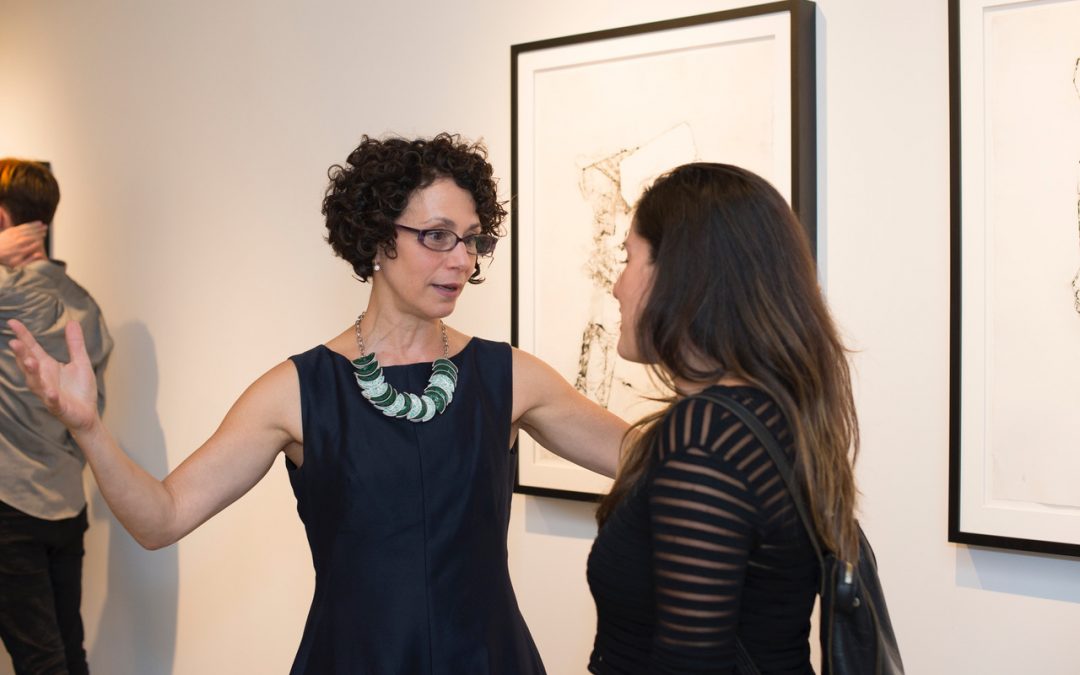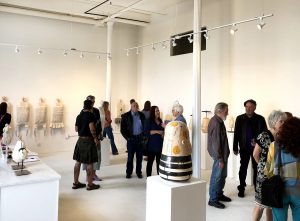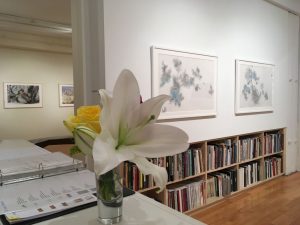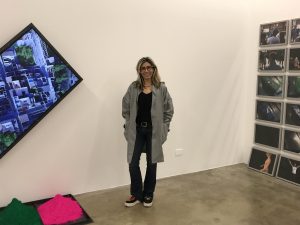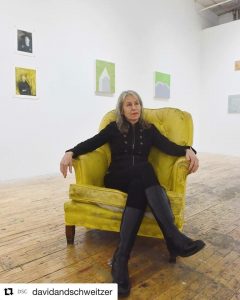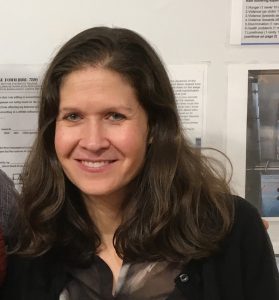Before you fire off an email to a gallery, do your homework. And don’t get your hopes up too high.
Out of idle curiosity, I recently asked a dealer friend about how many email submissions or inquiries she receives per week. I don’t precisely remember the answer, but the question seemed intriguing enough to reach out to a number of galleries about whether they will respond to this sort of “over the transom” approach. And what might catch their attention or generate a response.
After hearing from nine, I post the answers below. As I’ve advised before, there are some simple rules for approaching dealers. Study submissions guidelines on the gallery website. Understand that “no” usually does mean no. Don’t badger either via email or in person, and especially not at an art fair. If you’re interested in a particular gallery, show up at openings, artists’ talks, and other events.
Over and over, I hear that that an introduction via an intermediary—an artist, a collector, or a curator who has worked with the gallery—offers your best chance of getting taken seriously. And it never hurts to be nice.
Jen Tough, director, Jen Tough Gallery, Benicia, CA
I’d say we receive around 10 email inquiries a week; some weeks more, some less. I try to answer each, but admittedly, I don’t have the time, and therefore many remained unanswered. Which I generally feel bad about.
What tends to generate a response would be a more personal pitch. Why does this work fit in with my gallery? Using my name to address me (and spelling it correctly) is also a plus. And it’s always helpful if there is a personal connection—a mutual friend or an artist acquaintance, or if the artist approaching the gallery has been to openings or other events.
And, of course, amazing work always gets my attention.
Hal Bromm, director, Hal Bromm Gallery, New York, NY
Back when slides were in use, artists often mailed us packages hoping for feedback. Fortunately, many included return envelopes, but sadly too many artists sent images of practically everything they had ever created. It was clear that they had not considered asking friends or colleagues to help them edit. When I taught the course called “Art as Business, the Real World,” at the School of Visual Arts in New York I suggested to artists that the best way to have others review their work was by making sure that the people closest to them had seen the work and given honest feedback. Then if someone in an artist’s inner circle felt the work was ready for exposure, the artist could ask them to share that enthusiasm with others in a larger circle. I also advised self-editing and asking others to edit and select favorite works.
In recent years we usually get requests from collectors or friends of artists to look at work by artists they know and like, maybe one a month. I am happy to honor those requests by suggesting that the artist send images, but at the same time we say upfront that as an established gallery we have a full roster of artists and are not able to take on new people. Even for those who know this reality, there is always the palpable sense that they think the artist they are suggesting will blow us away.
That’s usually not the case, but artists suggested by third parties can lead to inclusion in a summer group show, or a recommendation from us to show the work to another gallery that might be open to taking a look.
Jim Robischon, Robischon Gallery, Denver, CO
I’d say I get four to six email inquiries a week. I have tried to have staff people handle some, but that never really seems to work out. I probably respond to only two or three a month, and more often than not that gesture is to offer advice. Generally, the artists will respond with a thank you. The rest I just have to let pass because the artist has never even looked at our website, much less visited the gallery in person. About 75 percent are so off the mark it is ridiculous.
We do have a form letter that is meant to educate artists in how to go about approaching the gallery, but occasionally something will really annoy me, and I’ll send a personal email telling them not to do this or that, Like sending me PDFs that are 250 MB.
I will definitely respond if the artist has done her homework and the work is in the vein and caliber of our other artists.
Liz Garvey, director, Garvey/Simon Gallery, New York, NY
Probably 20 artists a week will send in unsolicited emails (often with lengthy notes). They also send notes to my staff at the info@ address, unsolicited and sometimes with large attachments.
We have a simple response that goes out to each, telling them about our review program, the “Select” show, and how they can apply if they are interested. Of those, only a few actually submit works.
I ask artists to pay a small fee of about $20 or so for me to look at their website and review the work online. If I am intrigued and think it could be compatible with the show and our program, then they are invited to the next stage—they pay a second fee and are instructed to send a tailored statement as to why they think their work is a good fit for us, along with a CV/bio and 5 or so jpgs of the work. If I am still interested, the artists are invited to bring (or send) their work to the gallery so I can see it in person and get to know them a bit.
We have had about 40 overall submissions this year, and of those I have selected about 20, inviting them to bring their work to the gallery.
My goal is to select fewer than 10 artists for a curated show that will feel cohesive and give each artist space to shine. If they are not selected for the show, but I really like the work, I invite them to keep in touch with me.
The total amount paid per artist, if they end up being invited to the gallery for an in-person meeting/viewing, is about $50 (But only about $23 or so if they don’t make it to round two.)
Max Baseman, director, 5. Gallery, Santa Fe, NM
Between Instagram, Facebook, and email, I probably receive about ten direct requests a week—some weeks more than others. Many of these emails contain links to websites or have images attached. I will always take a look at the links and images, and I will try to set up studio visits for every (possible) approach that I get (Poland, England, Scotland, etc. being a tad far for me to visit these days). The timing for studio visits depends where we are with the current show or an upcoming show—a lot goes into the uninstalling and installing each show and unfortunately some requests fall through the cracks during these times.
Many of the people who venture into the gallery, come to openings, or whom I meet out and about are also artists. Some ask directly about whether or not I do studio visits and sometimes it simply comes up in conversation. I always mention that I would love to see what someone is working on and if they are interested, I ask them to email me so we can start looking at a date and a time that works for everyone.
And finally, there is the work and artists recommended by other artists and collectors. This is always nice to see, and these are generally good tips to follow, not to mention that artists tend to have a good eye and it never hurts to see people helping each other out—we’re all in this together.
Liliana Bloch, director, Liliana Bloch Gallery, Dallas, TX
Our submission process is closed because it breaks my heart to send rejections. In addition, I don’t have time to respond. Usually, most of what I receive is far from the quality and vision of our gallery (most of it is actually terrible). I tend to look at the artists referred to me by my roster—curators and collectors I trust—and those who interest me from my own research.
I will respond to an incredible, amazing, different, challenging, and smart body of work. Consistency in the artist’s production over the years is also huge for me. In my experience, I have found that outstanding artists “got it right” extremely early on in their career. Age is never a factor for me, or at least I try never to take it into consideration. (Carmen Herrera comes to mind as I’m writing my answer.)
American artists have a huge challenge now and for years to come. The U.S. has some of the best art programs in the world, and there is a lot of talent out there. Perhaps we are now saturated, thanks to Instagram, Twitter, Pinterest, Facebook….the list goes on. Nonetheless, talent is not enough anymore. Craftmanship means nothing if the work is not innovative aesthetically and conceptually.
Michael David, artist and co-director, David&Schweitzer, Brooklyn, NY
We receive about ten inquires a week from artists. Nothing in particular will generate a response, unless I see something in the work that looks promising and fits in with the gallery’s program. I wish we had more time to respond, but generally we don’t.
An image or two embedded in the text of the email is a great idea, and of course artists should always provide a link to the website. If a knockout image catches my eye, I might slow down and take a longer look.
Lesley Heller, director, Lesley Heller Gallery, New York, NY
We clearly state on our website that we accept individual and curatorial submissions in July only, and we ask those interested to check back in June about submissions policies. Nonetheless, people will write, inquiring about our guidelines, and also submit throughout the year, which tells me immediately that these artists are not going to be great to work with.
You only get one chance to make a good impression. Coming into the gallery and leaving your card is not a good idea. If you’re interested in a gallery, my advice is to show up for everything on that dealer’s agenda. Then she may say, “I’ve seen you around for a while. I’ll take a look at your website.”
Your job as an artist is to research every gallery that interests you; check out carefully what’s on the website and visit firsthand to find out what which gallery could be a good fit for your work.
There are too many artists for the number of galleries that exist, and each has its own submission policies. Pay attention; do your homework. The way you behave is extremely important. Value the gallerist’s time. We are working very hard for the artists we already represent and can’t always stop to chat.
Karlyn Benson, director, Matteawan Gallery, Beacon, NY
I find unsolicited emails annoying. I also don’t appreciate it when an artist talks to me about his or her work during an opening or when I am busy in the gallery. There is a note on my website that says the gallery does not accept submissions, yet I still have artists saying “If you don’t accept submissions, how do I show you my work?” The answer is you don’t! Most of what I receive doesn’t relate to my programming at all. I don’t answer email inquiries unless I know the person is a regular gallery visitor or is from my local art community. I will respond if an artist says she contacted me because of a mutual friend, or if an artist I show makes a suggestion. I don’t mind receiving an email announcing a show or an artist newsletter, because that’s not asking me to do anything and I don’t have to respond. In the end, I wish more artists would do their research and not approach a gallery if their work is not a good fit.
